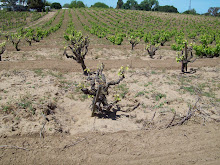We’d been drinking the wine for a decade, but only somewhere between the smog check station and Trader Joe’s did I finally see the vineyards where the grapes were grown.
When my wife, Kathy, had her job transfer come through, we were suddenly transplanted from Seattle to the East Bay of Northern California. We had rented in San Francisco over a decade before, during the 0.5% citywide vacancy rate of the dot-com years; it was during this period that we were able to rent a car to jaunt up to Napa and Sonoma to taste wines that were previously just labels on the shelf at West Seattle Thriftway. Cline, Rosenblum, Jade Mountain, Bogle: They all had a physical presence over the Golden Gate Bridge in “Wine Country.”
Last summer, we sold our little 1,000-square-foot house for a nice profit, and were able to purchase a foreclosure three-and-a-half times the size in Oakley, California, about two hours east of SF, in Contra Costa County. California has been walloped pretty badly by the mortgage crisis, and Oakley more so than many cities; compounding my slight uneasiness was the idea that, although we really do love the house, it represented the embodiment of much of what we loathe about suburbia: a big honkin’ multicar garage that takes up more than half of the front of the place; no public transit (the end of our BART line is still 16 miles west of the house); neighbors who use their recycling bins for garage storage; and a rich, local agricultural heritage that the building of our housing development, I suspect, had probably chipped away at.
But there was one agricultural presence that always puzzled us: Everywhere we drove, there were these old, gnarly looking woody shrubs stretching for what seemed like miles beside the pavement. Whether Kathy and I would be on notoriously clogged Highway 4, the main drag by the high school, across the street from a strip mall, or surrounding a 55+ “active seniors” development of $500K+ McMansions, the gnarly shrubs would be there. Kath and I naturally assumed that they were table grapes for snacking on, but come early February, we’d spot crews of workers out in the vineyards, cleaning up the sprouting canes and shoots. Visiting a winery tasting room in nearby Brentwood (the East Bay city, not O.J.’s Los Angeles neighborhood), we were shocked to be informed that these “shrubs” were, in fact, 80- to 100-year-old grapevines: varietals such as Zinfandel, Petite Sirah, Mourvedre (the locals call it Mataro), Alicante Bouschet, Carignane, and others that have been sold to out-of-county wineries for decades. Hell, Cline used to make a red blend named “Cote d’Oakley.” And now we live here?
Whassup with that?
See, here’s the mystery about the wines of CoCo County, and our little burg in particular: Gnarled, head-trained, desirable old-school grapevines are everywhere, and often in the strangest locations. But there’s not a tasting room to be found, and the only signage indicating that this is a working vineyard contains verbiage along the lines of “No Trespassing.” Sometimes a Napa or Sonoma winery will give props to our vinous ‘hood by labeling a wine as a vineyard designate: Neyers and Rosenblum have done Pato Vineyard Zins and Mourvedre from Rich Pato’s plot a few blocks away from the house. But not having a specific American Viticultural Area (AVA) designation, like, say, Napa Valley, Carneros, Red Mountain or Willamette Valley, our neck of the woods, with its unique sandy soils and original, disease-resistant rootstock, seems content to shun the spotlight. The only clue tossed to someone who wants to drink local is liable to be the expansive “Contra Costa County” on a label.
So, I guess that that’s the “raisin d’etre” for these meandering ramblings: My wife and I want to drink more wine made from the grapes growing by the side of the road in our new city. But to do that, we’ll have to discover who owns the vines, what varietal is hanging off of ‘em, and what wineries up and down the state they sell to.
It’s been 10 years since we lived in San Francisco, but if there ever was a project to meld Petite Sirah and Sam Spade, this just might be it.
Subscribe to:
Post Comments (Atom)

No comments:
Post a Comment